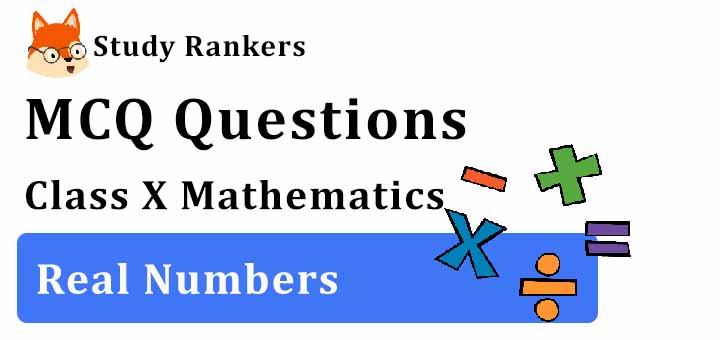MCQ Questions for Class 10 Maths: Ch 1 Real Numbers

1. A number when divided by 61 gives 27 as quotient and 32 as remainder . find the number
(a) 1967
(b) 1796
(c) 1679
(d) 1569
► (c) 1679
2. The sum of a rational and an irrational number is
(a) Rational
(b) Irrational
(c) Both (a) and (c)
(d) Either (a) or (b)
► (b) Irrational
3. The product of a rational and irrational number is
(a) rational
(b) irrational
(c) both of above
(d) none of above
► (b) irrational
4. The decimal expansion of the rational number 47/2352 will terminate after:
(a) one decimal place
(b) two decimal places
(c) three decimal places
(d) more than three decimal places
► (c) three decimal places
(a) one decimal place
(b) two decimal places
(c) three decimal places
(d) more than three decimal places
► (c) three decimal places
5. √7 is
(a) An integer
(b) An irrational number
(c) A rational number
(d) None of these
► (b) An irrational number
6. For positive integers a and 3, there exist unique integers q and r such that a = 3q + r, where r must satisfy:
(a) 0 < r < 3
(b) 1 < r < 3
(c) 0 < r < 3
(d) 0 < r < 3
► (a) 0 < r < 3
7. HCF of 8, 9, 25 is
(a) 8
(b) 9
(c) 25
(d) 1
► (d) 1
8. Which number is divisible by 11?
(a) 1516
(b) 1452
(c) 1011
(d) 1121
► (b) 1452
9. A lemma is an axiom used for proving
(a) other statement
(b) no statement
(c) contradictory statement
(d) none of these
► a) other statement
10. A terminating decimal number
(b) a rational number
(c) an irrational number
(d) Both (a) and (b)
► (b) a rational number
11. The smallest composite number is:
(a) 1
(b) 2
(c) 3
(d) 4
► (c) 3
12. The largest number that will divide 398,436 and 542 leaving remainders 7,11 and 15 respectively is
(a) 17
(b) 11
(c) 34
(d) 45
► (a) 17
13. For some integer p, every odd integer is of the form
(a) 2p + 1
(b) 2p
(c) p + 1
(d) p
► (a) 2p + 1
14. π is
(a) a rational number
(b) an irrational number
(c) both (a) & (b)
(d) neither rational nor irrational
► (b) an irrational number
15. The smallest composite number is:
(a) 1
(b) 2
(c) 3
(d) 4
► (c) 3
16. The largest number which divides 60 and 75, leaving remainders 8 and 10 respectively, is
(a) 260
(b) 75
(c) 65
(d) 13
► (d) 13
17. The least number that is divisible by all the numbers from 1 to 8 (both inclusive) is
(a) 840
(b) 2520
(c) 8
(d) 420
► (a) 840
18. 1/√3 is -
(a) A rational number
(b) An irrational number
(c) A whole number
(d) None of these
► (b) An irrational number
19. The product of three consecutive integers is divisible by
(a) 5
(b) 6
(c) 7
(d) none of these
► (b) 6
20. Every positive even integer is of the form ____ for some integer ‘q’.
(a) 2q
(b) 2q – 1
(c) 2q + 1
(d) none of these
► (a) 2q
21. The largest number which divides 615 and 963 leaving remainder 6 in each case is
(a) 82
(b) 95
(c) 87
(d) 93
► (c) 87
22.The product of a non zero rational and an irrational number is
(a) Always irrational
(b) Always rational
(c) Rational or irrational
(d) One
►(a) Always irrational
23. The HCF and LCM of two numbers is 9 and 459 respectively. If one of the number is 27, then the other number is
(a) 459
(b) 153
(c) 135
(d) 150
► (b) 153
24. Two natural numbers whose difference is 66 and the least common multiple is 360, are:
(a) 120 and 54
(b) 90 and 24
(c) 180 and 114
(d) 130 and 64
► (b) 90 and 24
25. The least positive integer divisible by 20 and 24 is
(a) 360
(b) 120
(c) 480
(d) 240
► (b) 120
26. For any two positive integers a and b, there exist (unique) whole numbers q and r such that
(a) q = ar + b , 0 ⩽ r < b.
(b) a = bq + r , 0 ⩽ r < b.
(c) b = aq + r , 0 ⩽ r < b.
(d) none of these
► (b) a = bq + r , 0 ⩽ r < b.



















